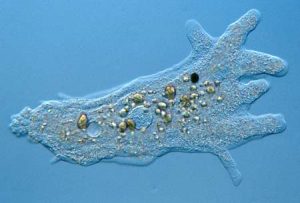 +
+ ![]() ≡
≡ 
 +
+  ≡
≡ 
The latest Darwinian rage is the newly sequenced Sea Urchin genome, which shows a surprising relationship to humans.

I don’t know how much similarity we are suppose to have with the sea urchins, but I thought we would review what does past sequenced similarity mean. The two examples above show what it means to be human. If we combine rice genome (approximately 30% human) with a C. elegans (approximately 70% human), would we get Einstein? Or if we combine a mouse (approximately 80% human), with a daffodil (approximately 20% human), we would get another Einstein, right? I think even some of the Brights are smart enough to realize this is not going to work. So what does it mean to be X% human? Apparently to be X% human means nothing, in a qualitative sense. It is possible to be 70% human and still not have any limbs, eyes, nose, ears or rationality. The question then becomes, why do the Darwinian Priors constantly throw out these percentages as if it means something? We’ve all heard it before, the chimp DNA is 99% the same as human DNA. Assuming there is a 99% match, does this make the chimp 99% human? Darwinian Priors are clueless about the genetic basis of what makes us so phenotypically and qualitatively different from chimps. If humans are 99% identical to chimps, why don’t these Darwinian Priors tell us which genes are responsible for each of the differences between the two species? Why don’t they provide us with empirical evidence of how these genetic differences came about? Even in the face of scientific evidence against Darwinian evolution, Darwinian Priors continue to use the bogus 99% identity between chimps and humans to promote the ideology of shared common ancestry. How do we know there is common ancestry? Well, because you look like a chimp, so says the Darwinist. Or to say it more euphemistically, we have many morphological similarities with the chimpanzee. You look like it so you must be related to it. But never fear we now have modern genetics and it verifies that we are indeed related to the chimp. Our DNA is 96% to 99% similar to that of the chimp. How do we know this? Well, because our DNA looks similar. These proclamations are the consensus of our best and brightest Darwinian minds. This is the only explanation that our best and brightest can come up with? No wonder our schools are turning out so many uneducated kids. When it comes to biological science the what and how does not matter any more. We don’t need empirically testable evidence. As long as it looks like it to you then it is a fact of science. Because the Darwinian Priors have declared Neo-Darwinian evolution is a fact, questioning it would be tantamount to being anti-science and a flat-earther. That means you and the chimp share a common ancestor is de facto scientific fact devoid of empirical evidence. This is the Darwinian Prior propaganda and fairy tale. e.g. How, when and what was the genetic basis for the enlarged brain size, function, and endocranial volume from 400cc to 1,200cc. IOW, do the Darwinian Priors know which gene(s) is responsible for this one particular change? The correct answer is no they don’t but that won’t stop them from declaring to you and the chimp are cousins. We just need to repeat the mantra that our DNA is 99% the same as the chimps. What they don’t tell the public is the footnote to the 99% similarity is the 80% of the proteins from our coding genes are different from the chimps. According to this study Eighty percent of proteins are different between humans and chimpanzees. The study compared 127 orthologous protein between humans and chimps. These are protein that is assumed to have common ancestry due to their similarities. Yet even in the most similar proteins between these two species, 80% of them are different, with variation from 1-16% of the amino acids are different. This begs the question, what about the non-orthologous proteins? Humans are purportedly to have over 70,000 proteins, 127 is just a drop in the bucket. If there are only 127 orthologous proteins does this mean the balance are non-orthologous? Ultimately we are controlled by our proteins, there must be something that the Darwinian Priors are ignoring, maybe like the 97% non-coding regions of the DNA or the undiscovered gene functions that produced the balance of the non-orthologous proteins. The other footnote is that only 1.5%-3% of our genomes is composed of coding genes. The rest are junk-DNA or non-coding genes. Many of the regulatory functions are in this so-called non-coding region or what they used to call junk DNA. We are now finding more and more functions in these non-coding genes. This again reminds me of a RPG game that I used to play.
This reminds me of the role-playing game Wizardry. I was always too impatient when playing these games, so I cheated. I hacked into the character database and changed my game character attributes. I gave myself maximum strength, agility, intelligence, constitution and whatever else was used. I also hacked the character profile to give myself certain items that would be helpful in the game world. However, there were always these stretches of attribute deserts like junk DNA. I was never able to complete the game through cheating. I was always missing some item to get me through the secret passageway or lack the ability to see certain hidden doors. The only people who knew where those hidden markers were are the programmers who programmed the games and knew where to check for those codes that would allow me to pass. Playing with genomes reminds me of playing with Wizardry.
So does 99% identity have any significance to who and what we are? It certainly doesn’t seem to have any relevance in illuminating where we came from. There is another irony in this chimp-human Darwinian fairy tale. Darwinian Priors contend that Man and chimp’s common ancestor was an ape like creature. It moved on all four limbs and eventually acquired bipedal locomotion. I don’t need to go into the detail; we all know the fairy tale. The irony is that scientific reality contradicts this fairy tale.
Here is how geneticist Giuseppe Sermonti puts it.
With paleontological dating of the histories of humans and horses, which began together and continued in parallel, it has become clear that the steed’s molecules have “decayed” seven times faster than those of its rider. From the moment that the human line became detached from that of the chimpanzee, hominids have clocked 13 “misprints” in mitochondrial DNA comapared to 34 in the chimpanzee. This means that, from the chemical standpoint, humans have changed much less than chimpanzees when compared with their common ancestor. In strict terms this shows that humans have evolved much less than African apes, implying that the common ancestor was, if anything, more human than ape and that the human line has remained, as it were, more baby-like than its quadrumanous cousins. (Giuseppe Sermonti, Why Is A Fly Not A Horse?, p 77)
Another problem with using DNA to indoctrinate common ancestry is the C-value paradox. The paradox being according to Darwinian evolution genomic information is accumulated over time. An eukaryote should have more genomic information than a prokaryote, because one was derived from the other. The parent genome evolved through accumulation and modification of information over time. Darwinian evolution predicts that genomic content should increase with successive generation of more complex organism. e.g. The genome should get larger as a fish evolves into an amphibian, an amphibian into a reptile, into a mammal. As a matter of fact the Darwinian Priors would point to the once called “junk DNA” as evidence for the remnants of our evolutionary past. Our non-coding DNA are vestigial refuse that have been copied, modified and discarded. This Darwinian fairy tale works fine until you discovered that some salamanders have 40 times more DNA than humans.
Mammals have around five billion pairs of nucleotides, reptiles around three, birds, around two, and fishes between 0.3 and 3.0 billion pairs. So far so good. But what about amphibians, which have about ten billion pairs and in some cases 100 billion — a level one finds in several dipnoid fishes as well? The mollusks have levels of DNA like those of the vertebrates, and worms like those of the birds. Flowering plants waver between two and 500 billion pairs. DNA, as we said is the stuff genes are made of, and, since genes are directly involved in metabolism, it was thought that a gene count might offer a better index of organismal complexity. Anywhere from three to five thousand genes have been counted in bacteria, 6,000 in yeast and 25,500 in one of the Cruciferae, 13,600 in the midge and 26,000 in Drosophila. Man, in whose genome should have been found his entire civilization and his destiny “25,000-30,000”, while Caenorhabditis elegans, a small worm 1mm long with only a thousand cells has almost 20,000. And where did all this lead? To the conclusion that biochemical complexity has little to offer in explaining evolution. (Giuseppe Sermonti, Why Is A Fly Not A Horse?, pp 38-39)
Who is the king/queen of the genome size war? That honor goes to drum roll, I give you the protozoa Amoeba dubia.

It weights in at 670 billion base pairs, over 200 times larger than the human genome. To paraphrase Professor Sermonti’s conclusion, raw DNA statistics has little to offer in explaining evolution.
